SilviScan™ rapid wood analysis
Wood is the most versatile material on Earth. It is used for an extraordinary array of products, and is even seen as a renewable source of fuel and chemicals in a world of decreasing oil reserves. The ability to measure the properties of wood is fundamental to forest assessment and genetic improvement programs, and to an understanding of all uses of wood, including carbon capture.
SilviScan® was conceived by Dr Robert Evans and developed with his CSIRO team to meet the requirements of plantation assessment and breeding programs. SilviScan® is unique in its ability to automatically and non-destructively assess the large numbers of trees produced by these programs.
SilviScan® technology has become the focus for a large proportion of CSIRO’s scientific and commercial activity in forestry and forest products research, as well as at the Swedish Pulp and Paper Research Institute (now Innventia) and the Pulp and Paper Research Institute of Canada (FP Innovations). Large numbers of researchers around the world have relied on, and continue to use SilviScan® data.
In recognition of his outstanding contributions Rob Evans was presented with the 18th Marcus Wallenberg Prize, referred to as the forest’s and forest industry’s ‘Nobel Prize’, by His Majesty King Carl XVI Gustav in Stockholm, Sweden in 2001 and the 2001 CSIRO Chairman’s Gold Medal.
With the detailed knowledge of wood quality and growth rate available from SilviScan®, nations can look forward to greater understanding of existing forests, and control over future forests, including their health and diversity, for the benefit of society and the planet.
An interest is kindled
As Rob Evans recalled a chance purchase as a fresh undergraduate changed his life: ‘In 1972, I spent my savings on an electric guitar made from a rainforest hardwood, prized for its beauty and musicality. Although mass produced, this guitar was unique by virtue of the naturally high variability of wood. To me it looked, felt and sounded better than did other guitars, even of the same model. At that time, I knew nothing of wood structure so the instrument’s appeal was purely subjective. I developed an interest in the musical qualities of wood and, a few years later, embarked on a career in wood science’.
Wood and us
Wood pervades our lives not only because it fulfils a wide range of performance requirements but also because we interact with it on a personal level. As consumers, we often judge forest products by a combination of practical, emotional, even ethical standards. Trees have sustained us in so many ways, and for so long, that we value wood quite differently than we do other materials such as concrete, steel and plastics. We surround ourselves with wooden surfaces and objects largely because we appreciate their visual and tactile qualities. In spite of manufacturing difficulties, we see the large natural variation in wood properties as a positive attribute.
Responding to industry
One hundred years ago, all of Australia’s wood originated from the native forests or was imported. Since then Australia has introduced exotic softwoods such as radiata pine in the temperate south and slash pine in the sub-tropical north. By the 1950s extensive plantations for timber and paper production were being established. Although Australian industry learned new ways to make paper from eucalypts, these species were used very little in plantations because of the availability of the native forest. By the 2000s eucalypt plantations were almost as extensive as those of radiata pine.
In 1988 the Australian Pulp and Paper Industries advised CSIRO of the need to include wood fibre properties in their tree improvement programs. Australian forestry’s short rotation times of one to two decades, rather than centuries, allowed the possibility of rapid improvement through genetic selection. It soon became apparent that there was no practical way to determine the key fibre properties of thousands of trees using current techniques. A single tree would have taken weeks to assess in detail.
The concept
Rob Evans remembers the beginnings of the idea:
One day in 1989, I was looking at micrographs of wood cross-sections and within a few minutes saw how high-speed automated analysis could be achieved using the natural tendency of wood fibres to grow in reasonably predictable patterns.
With a small budget, he began work on the development of new methods, in what was then the Division of Chemical and Wood Technology. By 1992, with the software skills of Murray Hughes and technical assistance of David Menz, David Tuttleby and Chris Kohle, an automated system was operational and capable of measuring a range of fibre properties in as many as 2000 radiata pine samples per year. The system was named SilviScan® by a Divisional colleague (Dr Russell Smith) who had no connection with wood science. The name derives from the word ‘silviculture’ ‘ the growing and tending of trees as a branch of forestry (Concise Oxford Dictionary).
By 1997, funding from the Australian Government Cooperative Research Centre Program supported the construction of a second instrument, SilviScan®-2, designed for the assessment of our plantation eucalypts. At various times, many colleagues in CSIRO and in other organisations were involved in aspects of image analysis, research projects and service work. The current generation system, SilviScan®-3, was constructed for the Swedish Pulp and Paper Research Institute (now Innventia), and another for the Pulp and Paper Research Institute of Canada (now part of FP Innovations). There are now three SilviScan®-3 systems in operation ‘ in Melbourne, Stockholm and Vancouver ‘ capable of measuring 10 000 samples per year.
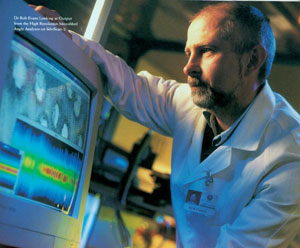
Fibre property measurement
SilviScan® is an integrated set of four instruments:
- the first is an image analyser used for measurement of fibre cross-sections
- the second is an X-ray densitometer used for measuring wood density
- the third is an X-ray diffractometer used for analysing the structure of the fibre wall, and
- the fourth (still under development) is a scanning spectrometer that can be calibrated to quantify chemical and physical information.
The instruments were all designed by Robert Evans and constructed in Melbourne by CSIRO staff and external contractors.
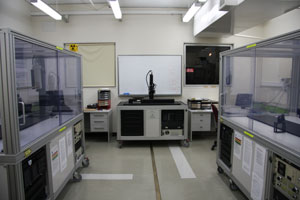
Together, these instruments measure many of the wood fibre characteristics of interest in papermaking and solid wood applications. SilviScan® is designed to use samples taken non-destructively from standing trees. These samples are in the form of cylindrical cores cut at breast-height from the bark through to the pith with a motorised hollow drill called an increment corer ‘ originally a Swedish invention. Each core is cut to a narrow strip for analysis. Fortunately, basic patterns of fibre property variation within trees are fairly predictable, so a 1 000 kilogram tree can generally be represented by a sample strip weighing only one gram.
SilviScan® is now being used in a wide range of basic and applied research and commercial programs. Current applications include inventory of wood and fibre properties, rapid screening of families and clones, assessment of environmental and silvicultural effects on wood, identification of genes controlling fibre properties, and modelling of wood, pulp and paper properties in terms of fibre properties.
Wood structure
Wood fibres are the building blocks upon which the entire forest products industry is based. In dry wood, a fibre is a closed hollow tube about 100 times longer than its diameter. Fibre lengths range from one to several millimetres. Their cross-sectional dimensions are critical to the performance in products such as paper. For example, thick-walled eucalypt fibres resist collapsing into flat ribbons during the papermaking process and give opaque sheets with high bending stiffness. These are suitable for printing and writing grades.
The structure of the fibre wall is quite remarkable. As the fibre develops in the tree, long strands of crystalline cellulose, called microfibrils, are produced by tiny biological machines called rosettes, which lie in parallel up and down the inside surface of the fibre wall. These rosettes are excellent examples of natural nanotechnology. During fibre wall production, the steepness of the spiral usually changes twice so that in the end there are three distinct layers in the fibre wall. The middle layer is the thickest, and the angle in this layer is called the microfibril angle. It is not known exactly how these angles are determined but it is known that they have a dramatic effect on fibre and wood properties, largely controlling stiffness, strength and shrinkage. When the microfibril angle is large, the fibre is flexible and tough. When microfibril angle is small, the fibre is very stiff, like a spring stretched close to its limit. Weight for weight, wood stiffness can rival that of steel, aluminium alloy or titanium. These fibres also contain lignin and carbohydrates that bind the microfibrils and fibres together to form solid wood.
SilviScan® uses X-ray diffraction to estimate the average microfibril angle of all the fibres in a sample within a few minutes although as Rob Evans recalled:
While it took 18 months to find a way to measure microfibril angle automatically, it took only seconds to recognise that the final, simple formula was the solution needed.
This information on microfibril angle is combined with density to estimate wood stiffness. Even better estimates are obtained when a contribution from the matrix that holds the microfibrils in place is included.
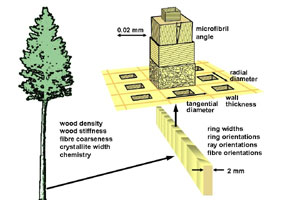
Some tree species, such as hoop pine are very uniform in fibre properties. Other species exhibit great variation. For example, Douglas fir in summer produces small diameter, thick-walled fibres with low microfibril angle whereas in spring the fibres have large diameter, very thin walls and a high microfibril angle. These differences make the Douglas fir summerwood as much as seven times stiffer than the springwood. Within a tree, stiffness could vary by a factor of twelve.
Now that tools to characterise wood and fibre properties in whole forests are available, how should that information be used?
The future
The ability to characterise wood properties is only the first step. The second, more difficult step is to connect wood fibre properties with the performance of a huge and growing number of products and processes. Although this work has been going on steadily for many decades, the mathematical modelling effort will have to increase dramatically, partly through global collaboration. Armed with new knowledge, informed decisions about the direction of the forest products industries can be made.
Some in the industry are taking a passive path on the assumption that they will be able to use whatever wood quality is available. They would measure wood properties at the end of the rotation and use the information to allocate the resource to a range of processes and products.
Others are taking an active path and include wood fibre properties in their tree improvement programs, relying on their ability to predict the market, the product types and the fibre properties when the trees are actually harvested. In Australia, we grow juvenile radiata pine with a rotation age of about 20 years, somewhat more for sawn timber. Prediction of market conditions and the types of products made in 20 years requires excellent models ‘ and courageous decision makers, as they may still be around when the trees are harvested.
In 1994, Dr Gene Namkoong received the Marcus Wallenberg Prize and spoke of robust breeding strategies that cater for uncertainty. We must be prepared to stretch our imaginations when planning tomorrow’s wood and fibre products. Multiple populations may then be bred to cover the whole range of possible futures.
How will Australia manage its rapidly expanding plantation resource to become a larger participant in the global forest products industry? Rob Evans view is as follows:
The answer clearly does not lie in greater investment in the production of commodities such as woodchips. We must add value (in its broadest sense) to the products we make and sell. This requires greater understanding of the relationships connecting wood structure, genetics, silviculture, and end uses. SilviScan® is playing a major role in establishing those relationships.
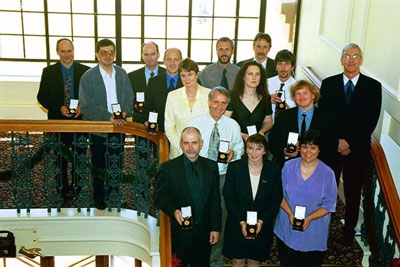
Honours and awards
Rob Evans is the author/co-author of 90 refereed papers, over 75 Conference papers, 5 Book Chapters, over 40 Technical reports/papers and 2 software products.
He was elected:
- 2007 CSIRO Fellow
- 2004 Fellow, Australian Academy of Technological Science and Engineering (ATSE)
- 1997 Fellow of the International Academy of Wood Science.
Other awards include:
- 2004 ATSE Clunies Ross National Science and Technology Medal, presented by Mr Hugh Morgan, Melbourne, Australia
- 2004 Josef Umdasch Prize to Prof R. Wimmer, Dr G. Downes and Dr R. Evans, Presented by Mrs Hilde Umdasch, Vienna, Austria
- 2001 18th Marcus Wallenberg Prize, presented by H.M. King Carl XVI Gustav, Stockholm, Sweden
- 2001 CSIRO Chairman’s Gold Medal, presented by CSIRO Chairman Ms Catherine Livingstone, Adelaide, Australia
- 1997 LR Benjamin Medal, presented by Appita President Mr Peter Brown, Brisbane, Australia.
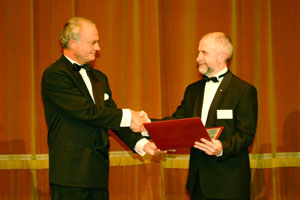
The Marcus Wallenberg Prize is very prestigious. The purpose of the Prize is to recognise, encourage and stimulate pathbreaking scientific achievements which contribute significantly to broadening knowledge and to technical development within the fields of importance to forestry and forest industries. Every year up to 500 organisations around the world are invited to nominate candidates for the Prize. Since its inception in 1981 until 2009 only two Australians have been awarded this honour, and both were from CSIRO. The first was Dr Robert H Leicester from CSIRO Manufacturing & Infrastructure Technology in 2000; the second Rob Evans.
Postcript
In looking back over his career Rob Evans commented:
I still have the guitar I bought when I was twenty-two. After almost four decades in forest products research I have a greater understanding of the relationships between structure and function and why my guitar looks, sounds and feels as it does. I also realise that its appeal is, to a large extent, subjective, and that our perceptions vary. In 2008 I was fortunate to work with my CSIRO colleague Andrew Morrow in his project on the effect of different woods on the sound of acoustic guitars. The differences were considerable, and it was clear that without the natural variability in wood, there would be little opportunity to match players and instruments. The Honduran mahogany of which my old guitar is made is now rightly protected in the wild. Plantation based replacements will allow far more uniform and predictable products. However, as we plan a future in which we make forests conform to ever tighter specifications, we must also propagate the variation that fuels both natural and anthropogenic evolution. It is no coincidence that variability plays a major role in our lives. Besides, in a world of uniform materials and techniques, I would not have had the pleasure of discovering my unique guitar.
Source
- Evans R, 2009, Personal communication.
